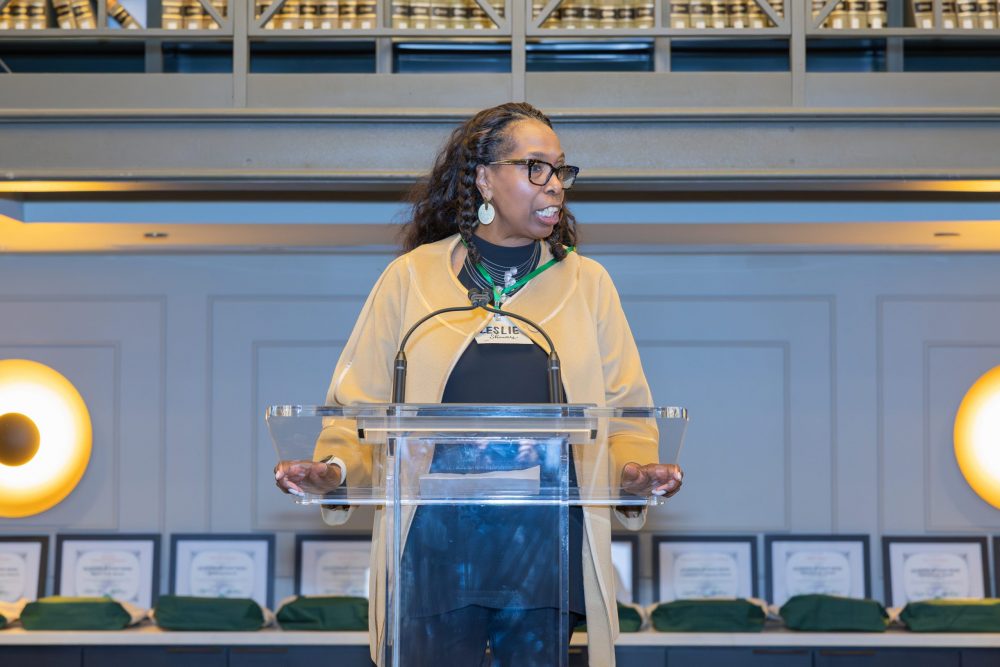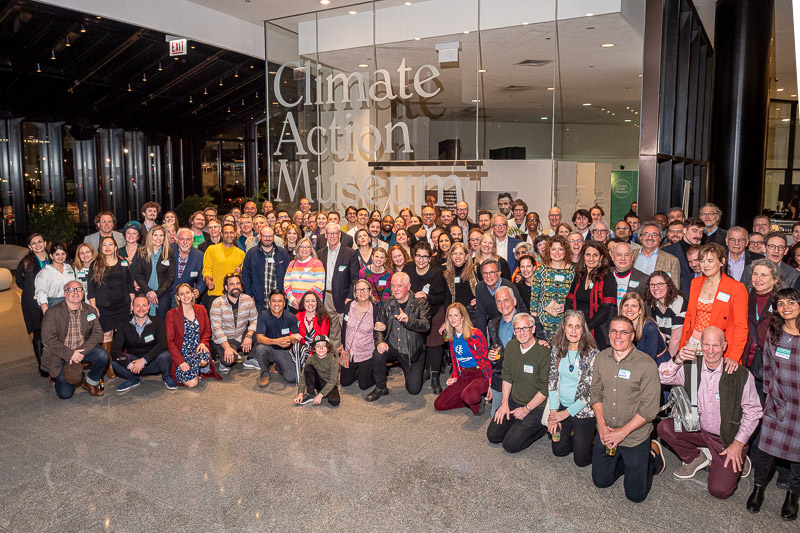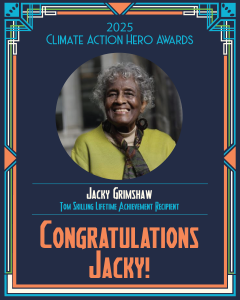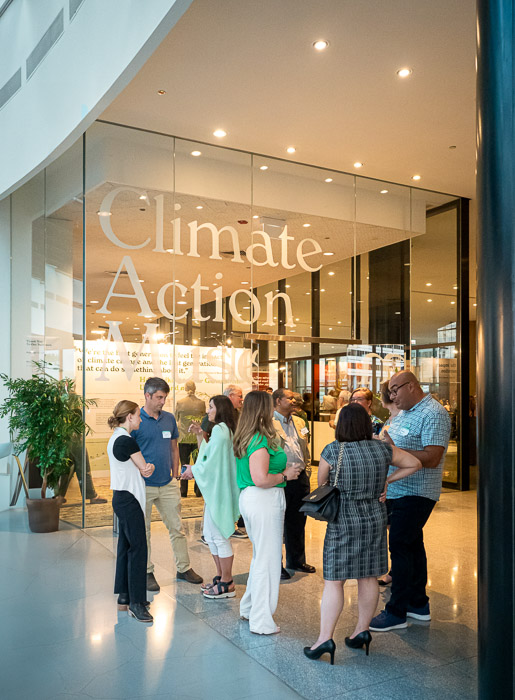Circular Economy Editor, Cynthia Milota, connected with Lesley Showers, Vice Chair of the Climate Action Museum (CAM), to discuss the museum’s role in education, stimulating critical thought and inspiring / facilitating action.
Located in downtown Chicago, one of just a handful of climate museums in the world, the CAM opened in June of 2023 and is celebrating their 2nd birthday (congrats!). Lesley Showers’ role guides the museum’s vision of fostering sustainable, inclusive change.
CAM was born out of a desire to bridge the gap between awareness and action around climate change.
– Lesley Showers

WDM: Before we get too deep into your involvement in the CAM, please share a bit about your background, education and your current “day job” at Institute for Cultural Affairs (ICA).
Lesley Showers: Thank you for the opportunity to share our work. I serve as the Executive Director of the Institute of Cultural Affairs (ICA), where I’ve had the privilege of working with communities, both local and global, to address some of the most pressing social and environmental issues of our time. My background is in organizational leadership, community development, with an educational foundation in public administration and nonprofit management, Architecture and Property Management. I’ve always been drawn to work that brings people together to generate collaborative solutions—and ICA has been a perfect fit for that mission.
WDM: Please tell us how the CAM got started and about the others that were involved in its conception.
Lesley Showers: The museum was developed over a cup of coffee. It started with Doug Farr’s/Farr Associates, desire to move the Energy Revolution Exhibit from the Chicago Architecture Center to anywhere where it would not end up in a landfill. Over the course of that coffee meeting, a museum now known as CAM was born.
In January of 2023, the first “meeting of the whole committee” a group of educators, artists, activists, and sustainability professionals came together to create a space that not only educates but inspires. We saw that people often feel overwhelmed by climate issues, and we wanted to create a place where they could see real, tangible solutions and feel part of a broader movement and conversation. From there, CAM evolved, guided by a diverse team of collaborators, including environmental designers, youth leaders, and community-based organizations that all brought their unique perspectives and passion to the table.

WDM: Please share the CAM mission and how it’s reach is beyond its Chicago physical location?
Lesley Showers: CAM’s mission is to make climate action accessible, hopeful, and community-driven. While our physical space is located in Chicago, our impact extends much further. Through virtual programming, traveling exhibits, and partnerships with schools and organizations, we reach audiences across the U.S. and internationally. We also offer digital storytelling resources to bring climate action into classrooms, boardrooms, and community centers. Our ultimate goal is to spark local action by showing that meaningful change is possible everywhere.
WDM: In our conversation, you mentioned the CAM’s focus on youth and getting young people involved in the conversation. Tell us more about how CAM engages learners of all ages.
Lesley Showers: For me, youth are at the heart of CAM’s work. I believe young people bring urgency, creativity, and clarity to the climate conversation.
- For students:
- CAM runs youth ambassador programs that equip students with the tools to become climate storytellers and community leaders.
- We also host intergenerational workshops, school field trips, and climate clubs that connect youth with experts and mentors.
- For adult learners:
- We offer facilitated dialogues, policy forums, and exhibitions that dive deep into circular economy practices, and systems thinking.
Our goal is lifelong learning—because everyone has a role to play.
– Lesley Showers
WDM: Recently the CAM hosted the 2nd annual Climate Action Hero Awards. Share with us the story of how the awards came to be and some details about this year’s event.
Lesley Showers: The Climate Action Hero Awards began as a way to spotlight individuals and organizations doing extraordinary work to combat climate change at local levels. Too often, climate solutions go unnoticed if they don’t make national headlines. We wanted to change that. This year’s event was a celebration of grassroots leadership—honoring educators, activist, innovators, artists, policy makers and youth leaders. It was an inspiring reminder that climate heroes are all around us.

WDM: The content at the CAM explores local, regional and national topics. Kindly share a few of your visitor’s favorite exhibits, to give our readers of taste of what to expect during a visit.
Lesley Showers: Visitors love our
- “Climate Solutions in Action” exhibit, which showcases real-world projects—from composting programs in urban neighborhoods to net-zero architecture.
- Another favorite is “Blue Zones”. Blue Zones are geographic regions where people live significantly longer and healthier lives, often surpassing 100 years. These areas have been linked to specific lifestyle habits, including a plant-based diet, regular physical activity, strong social connections, a sense of purpose, and moderate alcohol consumption. All of this unique lifestyle factors make for a very low carbon and sustainable way to live.
- We also have a “Design for Circularity” installation that demonstrates how product and space design can drastically reduce waste and emissions.
The interactive exhibits invite participation, allowing visitors to map their own climate journey and commit to next steps.
Here’s one example of the content the CAM offers. Test your skills with these infrared images of Chicago buildings. Match the photo with the appropriate statement:

- This building heats its parking floors.
- This image captured the thermal profile of the buildings across the street.
- The projecting balconies on this building lack thermal breaks.
- This building heats its facade and lacks insulation altogether.
- Individual high-temperature radiators radiate heat through the wall.
- The exhaust system of this building does not recover waste heat.
- This building heats its roof.
- This building does not heat its parking.
(Quiz answers at the end of this article.)
WDM: We spoke about agency, whereby people act or intervene to produce a particular effect. How does CAM enable and encourage agency with your visitors and the wider audience?
Empowering agency is central to CAM’s mission. We know that climate anxiety is real—but so is climate agency.
– Lesley Showers
Lesley Showers: Each exhibit and program are designed to leave visitors with a sense of capability, not despair. We offer clear action pathways tailored to individuals’ roles—whether as parents, business leaders, designers, or students. CAM also partners with organizations to host climate hackathons, innovation labs, and panel discussion so that anyone can immediately put ideas into practice.
Our message is simple: you don’t have to do everything—but everyone can do something.
– Lesley Showers

The climate crisis is also a creativity crisis. It challenges us to reimaging how we live, work, build, and relate to the planet and each other. CAM exists to nurture that imagination. Whether you’re designing the next sustainable office, creating circular supply chains, or rethinking community spaces, we invite you to use CAM as a resource—and a reminder that bold, joyful action is both necessary and possible.
Images courtesy of CAM.
Engage with the CAM by
- Visiting CAM the next time you’re in Chicago’s loop.
- Bringing your team here for a tour or a meeting.
- Staying connected via the CAM newsletter.
- Watching videos of CAM events.
Infrared Building Quiz Answers: 1) a; 2) f & g; 3) c; 4) d; 5) e; 6) f & a; 7) b; 8) h.


